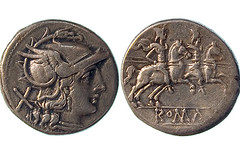
PREV ARTICLE
NEXT ARTICLE
FULL ISSUE
PREV FULL ISSUE
CANADIAN SCIENTISTS USING ANCIENT COINS TO MAP TRADING ROUTES
An article in Canada's Times-Colonist describes research into ancient trade routes including ancient coins.
-Editor
Researchers at McMaster University in Hamilton have launched a research project in which nuclear radiation is used to identify changes in metal content among ancient Greek and Roman coins held in a world-class collection amassed at the university since the 1940s. "As we determine what the coins are made of, we are then able to reconstruct ancient trade routes, understand the development of economies and even determine the extent of counterfeiting," McMaster archeologist Spencer Pope states in a project summary issued Tuesday. "This research will help us link the archeological to the historical to understand how we, as a society, got to where we are today." A joint project between the university's classics department and its department of medical physics and applied radiation sciences, the ancient coin initiative involves x-ray analysis and a "proton microprobe" to determine how much silver, bronze or gold is contained in each piece of money. "We use multiple systems to look for a number of metals — gold, copper, silver — present in the outer layer of the coins," said radiation scientist Michael Farquharson. "Then we use the McMaster Nuclear Reactor to penetrate deeper into the coin to determine whether or not the coin was plated with a different material than it was actually made of." Greater concentrations of tin, lead and other cheap metals in a coin can indicate its manufacture during a period of economic stress, inflated prices for more precious metals or low supplies of silver or bronze. Trace elements found in each coin can help researchers pinpoint its geographic and geological origins, said Pope, allowing the team to better understand where Greek city-states turned for metal supplies and how widely coins were circulated. So far, about 20 coins have undergone a deep probe. There are plans for another 100-coin study to expand the database of information and begin drawing more detailed conclusions about the economy of the ancient world.
To read the complete article, see:
Canadian scientists using ancient coins to map trading routes
(www.timescolonist.com/life/Canadian+scientists+ The Numismatic Bibliomania Society is a non-profit organization promoting numismatic literature. See our web site at coinbooks.org. To submit items for publication in The E-Sylum, write to the Editor at this address: whomren@gmail.com To subscribe go to: https://my.binhost.com/lists/listinfo/esylum All Rights Reserved. NBS Home Page Contact the NBS webmaster 
|
 Canadian scientists probing the metal content of coins exchanged thousands of years ago in Mediterranean Europe have discovered a new way to map ancient trade patterns, to retrace economic ups and downs at the dawn of Western Civilization and even to shed new light on the collapse of the Roman Empire.
Canadian scientists probing the metal content of coins exchanged thousands of years ago in Mediterranean Europe have discovered a new way to map ancient trade patterns, to retrace economic ups and downs at the dawn of Western Civilization and even to shed new light on the collapse of the Roman Empire.